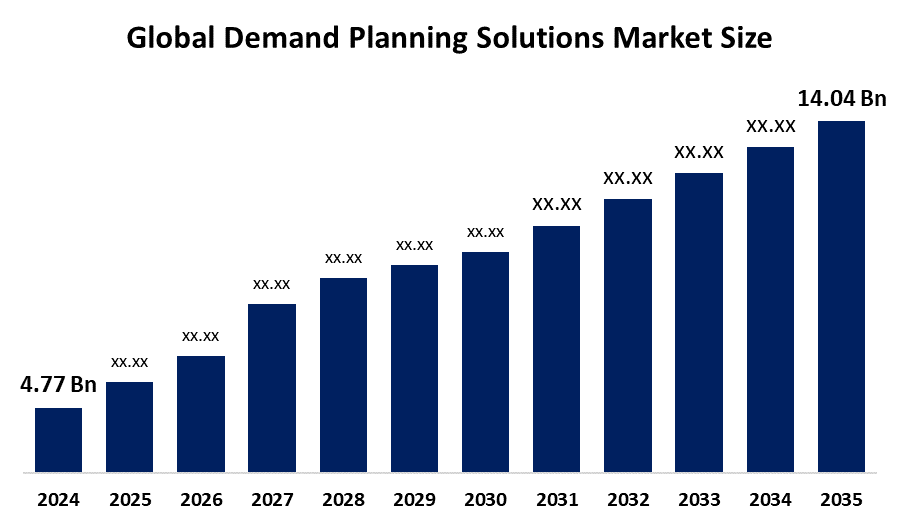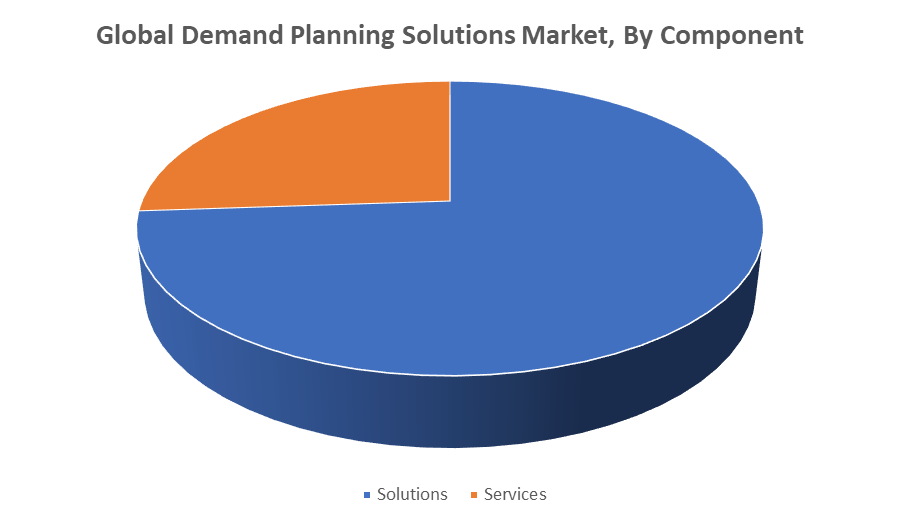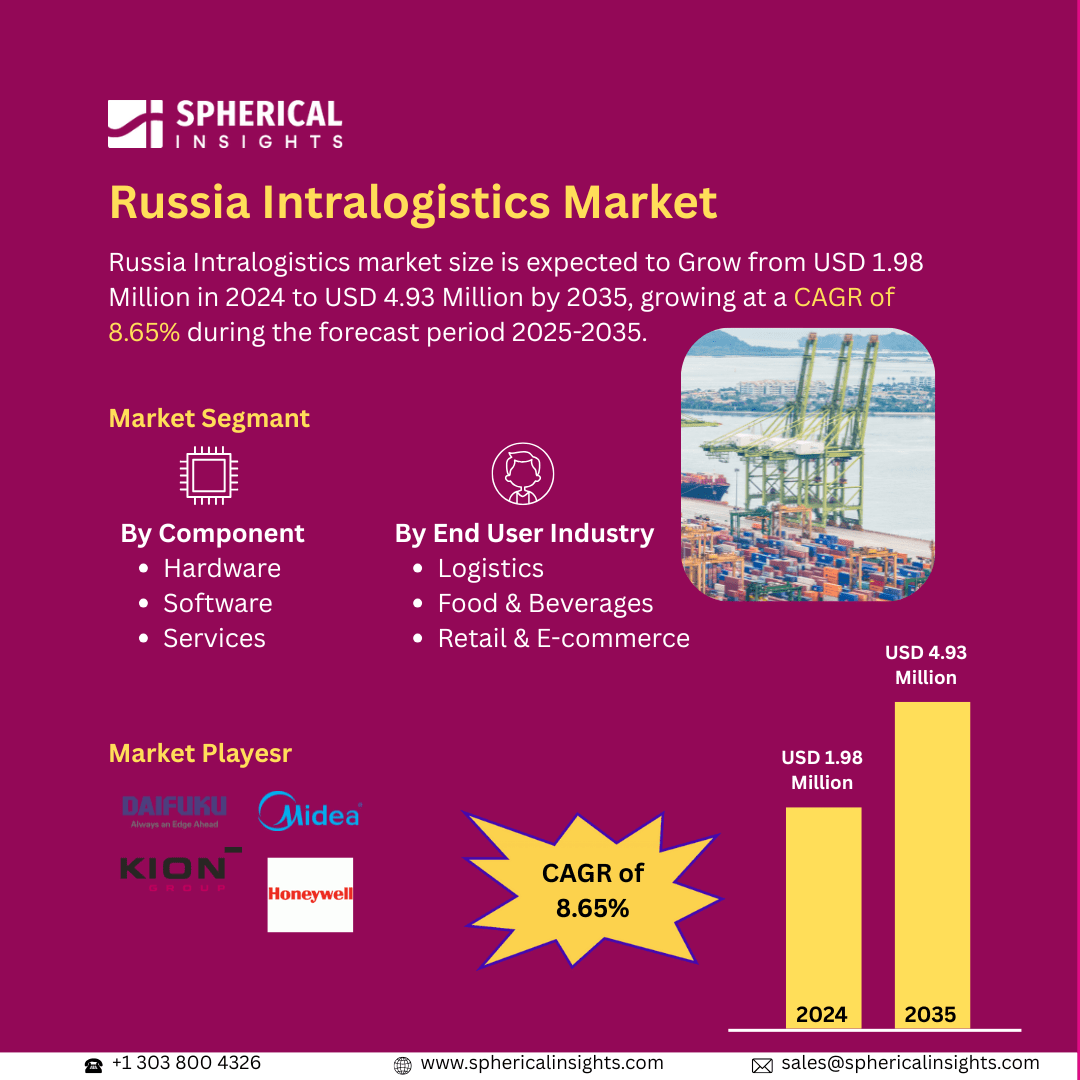Global Demand Planning Solutions Market Insights Forecasts to 2035
- The Global Demand Planning Solutions Market Size Was Estimated at USD 4.77 Billion in 2024
- The Market Size is Expected to Grow at a CAGR of around 10.31% from 2025 to 2035
- The Worldwide Demand Planning Solutions Market Size is Expected to Reach USD 14.04 Billion by 2035
- Asia Pacific is expected to grow the fastest during the forecast period.

Demand Planning Solutions Market
The Global Demand Planning Solutions Market Size involves software and systems designed to help organizations forecast customer demand accurately. These solutions utilize advanced analytics, machine learning, and historical data to predict future product requirements. By doing so, businesses can optimize inventory levels, streamline production schedules, and improve supply chain efficiency. Demand planning solutions are widely used across various industries, including retail, manufacturing, healthcare, and consumer goods. They enable companies to reduce excess stock and prevent shortages, ensuring better alignment between supply and demand. These tools often integrate with enterprise resource planning (ERP) and supply chain management systems, providing real-time insights and facilitating data-driven decision-making. As businesses increasingly focus on enhancing operational efficiency and meeting customer expectations, demand planning solutions play a crucial role in supporting strategic planning and resource allocation. The market encompasses a range of products, from basic forecasting software to sophisticated AI-driven platforms, catering to diverse organizational needs globally.
Attractive Opportunities in the Demand Planning Solutions Market
- As businesses seek more accurate and responsive forecasting tools, incorporating data from IoT devices and connected systems presents a major opportunity. These technologies allow real-time tracking of inventory, sales trends, and operational metrics, enabling faster, data-rich forecasting decisions. This is especially valuable in manufacturing, retail, and logistics, where real-time visibility can significantly reduce stockouts, overproduction, and waste.
- Emerging markets in the Asia Pacific, Latin America, and parts of Africa are experiencing industrial expansion and digital transformation. These regions strongly demand cost-effective, scalable demand planning tools tailored to local market dynamics and infrastructural challenges.
Global Demand Planning Solutions Market Dynamics
DRIVER: Increasing complexity in global supply chains demands
Increasing complexity in global supply chains demands more accurate forecasting tools to manage inventory and production efficiently. The rise of e-commerce and changing consumer behaviors require businesses to respond quickly to fluctuating demand patterns. Additionally, advancements in technologies like artificial intelligence, machine learning, and big data analytics have enhanced the accuracy and capabilities of demand planning solutions, making them more attractive to organizations. Companies are also focusing on digital transformation and automation to improve operational efficiency, reduce costs, and minimize waste. Integration of demand planning with other business systems, such as ERP and supply chain management platforms, further boosts adoption. Moreover, the growing need for real-time data and predictive analytics enables businesses to make proactive decisions, supporting better demand-supply alignment. Together, these factors contribute to the steady expansion of the demand planning solutions market worldwide.
RESTRAINT: Data quality issues
High implementation costs and complexity of integrating demand planning solutions with existing enterprise systems can deter small and medium-sized businesses from adoption. Additionally, a lack of skilled professionals to manage and interpret advanced analytics tools limits the effective use of these solutions. Data quality issues, such as incomplete or inaccurate data, can reduce forecasting accuracy and undermine confidence in the system. Resistance to change within organizations and reliance on traditional planning methods also hinder widespread adoption. Furthermore, concerns over data security and privacy in cloud-based demand planning solutions can create hesitation among companies. In some industries, unpredictable market conditions and external disruptions, like geopolitical tensions or natural disasters, make demand forecasting challenging despite advanced tools. These challenges collectively slow the market’s growth, particularly among businesses with limited resources or less technological maturity.
OPPORTUNITY: Incorporating data from IoT devices and connected systems
Emerging economies, with expanding manufacturing and retail landscapes, offer fresh prospects for tailored solutions that address regional supply chain challenges. There is also potential in creating highly specialized demand planning applications for niche industries like biotechnology, luxury goods, and renewable energy sectors. Incorporating data from IoT devices and connected systems can significantly improve forecast precision and responsiveness. Growing emphasis on sustainable practices encourages demand planning tools that help reduce waste and support eco-friendly supply chains. Furthermore, partnerships between software providers and logistics companies to build integrated, collaborative networks present new business models. Continuous progress in AI-driven automation and adaptive forecasting methods enables providers to innovate and differentiate their offerings in a competitive marketplace.
CHALLENGES: Ensuring seamless integration between demand planning solutions and a company’s existing IT infrastructure
One major challenge is managing the vast and diverse data sources required for accurate forecasting, including real-time sales, market trends, and external variables like weather or economic shifts. Ensuring seamless integration between demand planning solutions and a company’s existing IT infrastructure can be technically complex and time-consuming. Additionally, organizations often struggle with change management, as aligning cross-functional teams such as sales, marketing, and supply chain around a unified demand planning process can be difficult. The evolving nature of consumer behavior adds unpredictability, making it hard for models to consistently deliver precise forecasts. Another challenge is maintaining data privacy and complying with various international regulations, especially for companies operating across multiple regions. Finally, the fast pace of technological innovation requires continuous updates and training, which can strain resources and slow down adoption in some organizations.
Global Demand Planning Solutions Market Ecosystem Analysis
The global demand planning solutions market ecosystem includes solution providers who develop forecasting software, technology vendors offering cloud and IoT infrastructure, and data providers supplying crucial market and sales information. End-users span industries like retail and manufacturing, using these tools to optimize supply chains. Consulting firms and system integrators customize and implement solutions, while third-party logistics partners align distribution with demand plans. Regulatory bodies ensure compliance and data security. Together, these stakeholders collaborate to enhance forecasting accuracy and drive supply chain efficiency worldwide.
Based on the component, the solutions segment accounted for the largest market share over the forecast period

Solutions include software platforms that leverage advanced analytics, artificial intelligence, and machine learning to provide accurate demand predictions. These tools help businesses optimize inventory levels, reduce stockouts or overstock situations, and improve overall supply chain efficiency. The increasing adoption of cloud-based demand planning solutions further boosts this segment’s growth by offering scalability and flexibility. Additionally, companies are investing heavily in demand planning software to integrate with existing enterprise resource planning (ERP) and supply chain management systems, driving the dominance of the solutions segment in the market.
Based on the deployment, the on-premise segment held the highest market share during the forecast period
The on-premise segment held the highest market share during the forecast period due to organizations prioritizing greater control over their demand planning systems and sensitive data. Many companies prefer on-premise solutions for enhanced security, customization, and integration with existing IT infrastructure. This deployment model is especially favored by large enterprises in sectors like manufacturing, healthcare, and finance, where data privacy and regulatory compliance are critical. Despite the rising popularity of cloud-based solutions, on-premise demand planning continues to dominate due to its reliability and ability to support complex, tailored business processes.
North America is anticipated to hold the largest market share of the demand planning solutions market during the forecast period
North America is anticipated to hold the largest market share of the demand planning solutions market during the forecast period. This dominance is attributed to the region’s advanced technological infrastructure, widespread adoption of AI and big data analytics, and the presence of major demand planning solution providers. Additionally, North American businesses across industries like retail, manufacturing, and healthcare increasingly focus on optimizing supply chains and improving operational efficiency. Strong investments in digital transformation and a well-established regulatory environment further support the growth of demand planning solutions in this region.
Asia Pacific is expected to grow at the fastest CAGR in the demand planning solutions market during the forecast period
Asia Pacific is expected to grow at the fastest CAGR in the demand planning solutions market during the forecast period. This rapid growth is driven by the region’s expanding manufacturing and retail sectors, increasing digitalization, and rising adoption of advanced technologies like AI and cloud computing. Emerging economies such as China, India, and Southeast Asian countries are investing heavily in supply chain modernization to meet growing consumer demand. Additionally, the growing number of small and medium-sized enterprises (SMEs) in the region seeking cost-effective demand planning tools fuels market expansion. Improved internet connectivity and government initiatives supporting Industry 4.0 also contribute to the accelerating growth of demand planning solutions across Asia Pacific.
Recent Development
- In March 2023, Zionex launched PlanNEL Beta, an AI-powered SaaS platform designed for demand forecasting and inventory optimization. It utilizes machine learning, natural language processing, and computer vision to provide accurate demand forecasts and optimal inventory levels.
Key Market Players
KEY PLAYERS IN THE DEMAND PLANNING SOLUTIONS MARKET INCLUDE
- SAP SE
- Oracle Corporation
- Infor Inc.
- JDA Software (now Blue Yonder)
- Manhattan Associates, Inc.
- Kinaxis Inc.
- ToolsGroup
- E2open, LLC
- Logility, Inc.
- Zionex Inc.
- Others
Market Segment
This study forecasts revenue at global, regional, and country levels from 2020 to 2035. Spherical Insights has segmented the demand planning solutions market based on the below-mentioned segments:
Global Demand Planning Solutions Market, By Component
Global Demand Planning Solutions Market, By Deployment
Global Demand Planning Solutions Market, By Regional Analysis
- North America
- Europe
- Germany
- UK
- France
- Italy
- Spain
- Russia
- Rest of Europe
- Asia Pacific
- China
- Japan
- India
- South Korea
- Australia
- Rest of Asia Pacific
- South America
- Brazil
- Argentina
- Rest of South America
- Middle East & Africa
- UAE
- Saudi Arabia
- Qatar
- South Africa
- Rest of the Middle East & Africa





